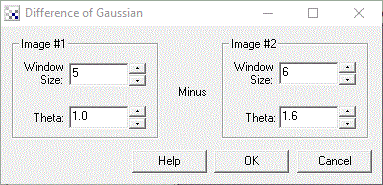Difference of Gaussian (DOG)
The Difference of Gaussian module is a filter that identifies edges. The DOG filter is similar to the LOG and DOB filters in that it is a two stage edge detection process.The DOG performs edge detection by performing a Gaussian blur on an image at a specified theta (also known as sigma or standard deviation). The resulting image is a blurred version of the source image. The module then performs another blur with a sharper theta that blurs the image less than previously. The final image is then calculated by replacing each pixel with the difference between the two blurred images and detecting when the values cross zero, i.e. negative becomes positive and vice versa. The resulting zero crossings will be focused at edges or areas of pixels that have some variation in their surrounding neighborhood.

1. Specify the window size and theta of the first blur to be performed. The window size is how large a Gaussian filter is applied to the image. If the filter is too small the Gaussian filter starts to approximate a box blur filter. If the filter is too large then values at the ends become zero and extra work is performed which slows down processing.
2. Specify the window size and theta of the second blur to be performed. Note that the theta should typically be larger then the first theta in order to correctly detect edges.
See Also
Gaussian Filter
Difference of Boxes
LOG
For additional information on Difference of Gaussian (DOG) see
Molecular Expressions Microscopy Primer - Difference of Gaussians Edge Enhancement Algorithm
Sussex Computer Vision: TEACH Vision3
Harvey Mudd College: Computer Image Processing and Analysis (E161)
| New Post |
| DOG Related Forum Posts | Last post | Posts | Views |
| None |
